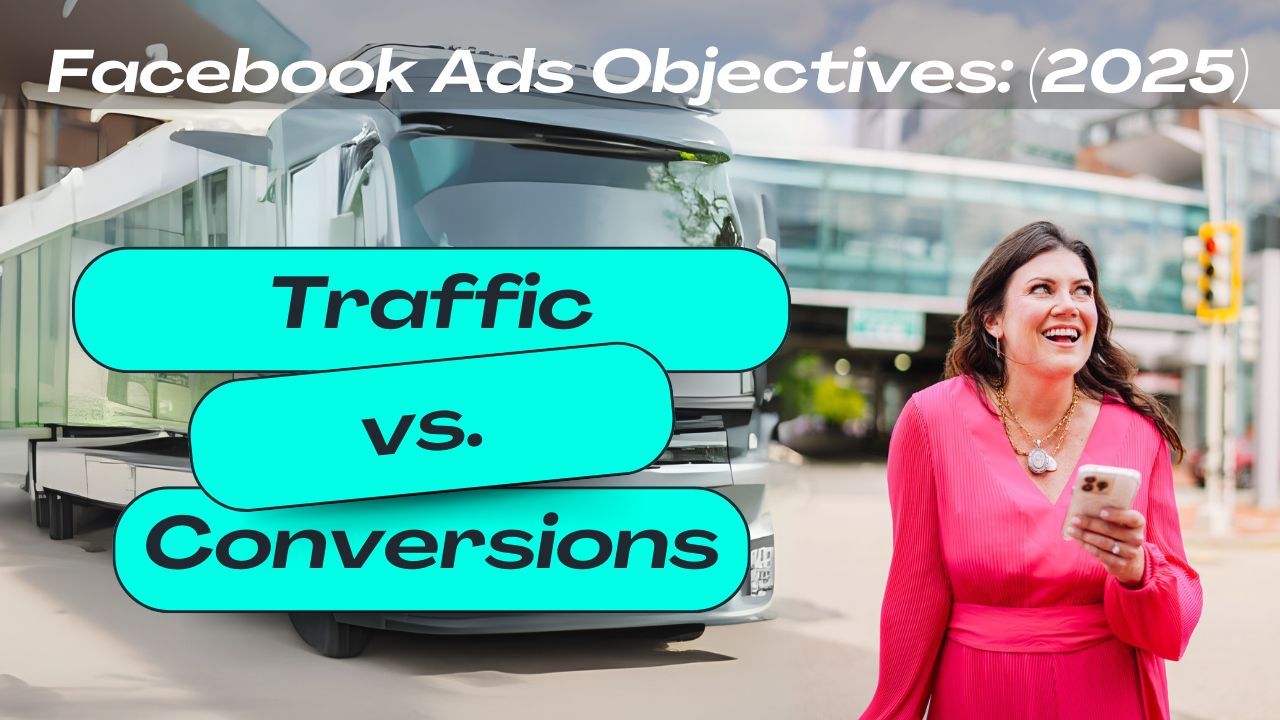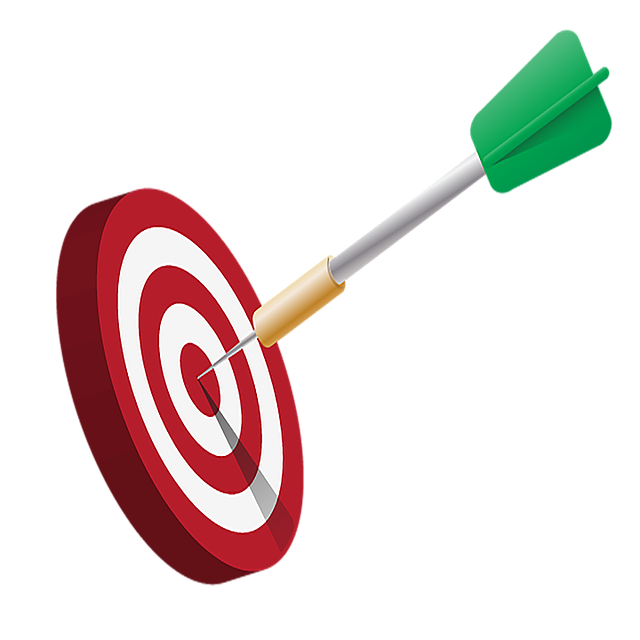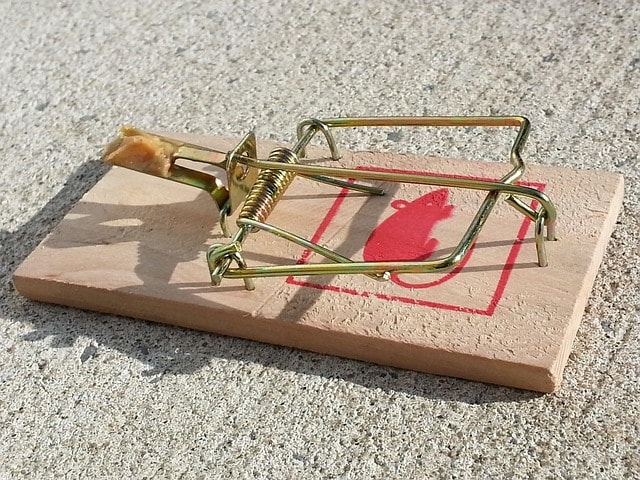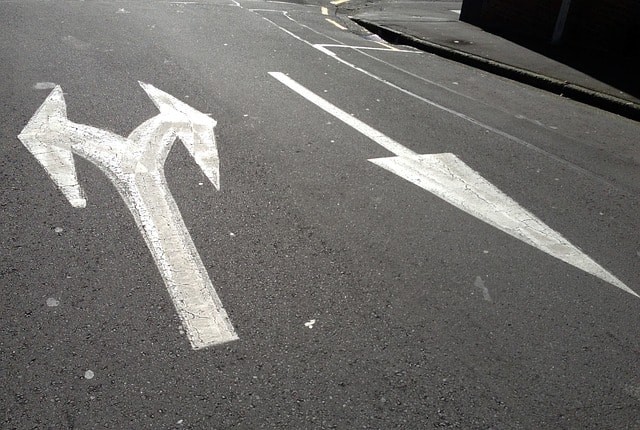
Facebook Ads Objectives: Traffic vs. Conversion Campaigns (2025)
If you’re running ads on Meta and wondering why some campaigns bring in big wins while others just burn cash, you’re not alone. The key? Knowing when to use which of the six available campaign objectives in Meta’s Ad Manager. Each has its place, but if you use them incorrectly, you’ll be leaving money on the table. Let’s break down two of the most popular objectives—Traffic and Conversion campaigns—that can be incredibly effective but are often misunderstood or misused.

Traffic vs. Conversion Campaigns: Understanding the Difference in Ads Objectives
A Traffic campaign is like casting a wide net—it gets people to click and visit your site, but it doesn’t focus on what happens after. Choosing the right campaign objectives is crucial for the success of your Facebook and Instagram ads. The traffic objective, for instance, is essential for driving visitors to your website and setting the stage for future conversion campaigns. A Conversion campaign, on the other hand, is all about getting people to take a specific action, like making a purchase, signing up for a webinar, or filling out a form. Meta’s algorithm actually finds people who are most likely to complete that action, making it a way more effective strategy when you’re looking for actual results.
Understanding Facebook Ad Objectives
Facebook ad objectives are a crucial part of creating effective Facebook ad campaigns. They determine the goal of your ad campaign and help Facebook’s algorithm optimize your ads for the best possible results.

Choosing the Right Facebook Campaign Objective
Choosing the right Facebook campaign objective is crucial to the success of your ad campaign. Here are some tips to help you make the right choice:
-
Define Your Campaign Goals: Before selecting an objective, clearly define what you want to achieve with your campaign. Are you looking to increase brand awareness, drive website traffic, or generate leads?
-
Understand Your Target Audience: Know who your target audience is and what they’re looking for. This understanding will help you choose an objective that resonates with them and meets their needs.
-
Consider Your Budget: Take your budget into account and choose an objective that aligns with it. For instance, if you have a limited budget, you might opt for an engagement objective rather than a sales objective to maximize your reach and interactions.
How and When to Use Each Type of Campaign
Meta Traffic Campaigns: Understanding the Traffic Objective
Traffic campaigns are ideal for the early stages of your marketing funnel, with the traffic objective being crucial in driving visitors to your website. They help generate brand awareness, introduce new products, and drive visitors to content like blog posts or videos.
Benefits of Traffic Campaigns:
-
Increased Brand Visibility: Exposes your brand to a wider audience.
-
Cost-Effective: Typically lower cost-per-click (CPC) than Conversion campaigns.
-
Audience Building: Helps create valuable retargeting audiences for later Conversion campaigns.
Example: A new online clothing store launching its spring collection could use a Traffic campaign to drive visitors to a landing page showcasing the new items. This builds initial interest and a retargeting audience for future Conversion campaigns.
Using Traffic Campaigns on a Budget:
-
Highly Targeted Audience: Focus on specific demographics to reach engaged users.
-
Compelling Creatives: Use visuals and ad copy that encourage clicks.
-
Landing Page Optimization: Ensure fast load times, mobile-friendliness, and a clear CTA.
Meta Conversion Campaigns
Conversion campaigns are designed to drive specific actions, such as purchases, sign-ups, or lead generation. One example is the ‘catalog sales objective,’ a targeted Facebook ad campaign designed specifically for ecommerce businesses. They are most effective when you’re looking to turn engaged prospects into paying customers.
Benefits of Conversion Campaigns: Including Lead Generation Objective
-
Higher ROI: Optimized for specific actions, leading to better returns.
-
Targeted Optimization: Meta’s AI finds users most likely to convert.
-
Measurable Results: Tracks specific actions like cost-per-conversion and ROAS.
Example: The same online clothing store, after running the Traffic campaign, could launch a Conversion campaign targeting users who visited the landing page but didn’t purchase, offering a discount or free shipping to drive conversions.

The Pitfalls of Misusing Traffic Campaigns
A lot of business owners think running a Traffic campaign will bring in sales, but here’s the problem—you’re paying for clicks, not purchases. That means you could be getting tons of visitors but no conversions. The result? Wasted ad spend and frustration.
Selecting the right ad objective is crucial for aligning your campaign with specific business goals. For instance, choosing an engagement objective can help you build a community, while a traffic objective drives visitors to your site, and a conversion objective focuses on turning those visitors into customers.
Example: An online course seller runs a Traffic campaign and gets clicks but few sales. If they had used a Conversion campaign, Meta would have targeted users who were more likely to buy, increasing ROI and reducing wasted spend.
Bottom Line: If your goal is an action—buying, signing up, or booking—always use a Conversion campaign. Save Traffic campaigns for brand awareness and audience building.

Budgeting Smart: How Much Should You Spend?
It’s tricky to give exact budget recommendations for Meta ads because it depends heavily on factors like your industry, target audience, campaign goals, ad quality, and competition. Utilizing the Meta Ads Manager, which now features an updated set of campaign objectives, can help you align your marketing goals more effectively. However, here are some general guidelines:
Traffic Campaigns:
-
CPC Range: $0.50 – $2.00.
-
Minimum Budget: $5-$10/day for small audiences.
-
Typical Budget: $20-$50+/day.
-
Goal: Generate high website traffic with lower conversion intent. Additionally, focusing on post engagement can help increase interaction with your audience through likes, shares, and comments on your posts.
Conversion Campaigns:
-
CPC Range: $2 – $10+.
-
Minimum Budget: $20-$50/day.
-
Typical Budget: $50-$100+/day.
-
Goal: Drive actual sales or lead generation with higher intent audiences. One effective strategy is the lead generation objective, which allows businesses to create Facebook ads with customizable contact forms to capture leads directly within the platform.
Understanding ROAS for Conversion Campaigns
ROAS (Return on Ad Spend) measures the revenue generated for every dollar spent on ads, and selecting the appropriate Facebook ads objective is crucial for optimizing this metric. A good ROAS varies, but 3-5X is a solid benchmark for many businesses.
Factors Affecting ROAS:
-
Industry & Competition: Some industries have higher ad costs.
-
Profit Margins: Higher margins allow for a lower ROAS.
-
Conversion Rate & AOV: Higher values lead to better returns.
-
Ad Quality & Targeting: Better targeting improves efficiency.

Working Backwards from Revenue Goals
Let’s say your revenue goal is $10,000/month and you’re aiming for a ROAS of 3. To achieve this, it’s crucial to select the right Facebook ad objectives that align with your business goals and customer stages: Formula: Ad Spend = Revenue Goal / ROAS Calculation: $10,000 / 3 = $3,333.33 ad spend required.
Recommendations for Success:
-
Start with a conservative ROAS target (2-3) and optimize over time.
-
Factor in additional costs like website development and content creation.
-
Monitor other key metrics like CPA (Cost per Acquisition) and CLTV (Customer Lifetime Value).
Want to understand better why the "experts" are asking you to spend so much on these conversion campaigns? Click here
Optimizing Your Campaigns
Once you’ve chosen your Facebook campaign objective, it’s time to optimize your campaigns for maximum ROI. Here are some tips to help you get the most out of your ad spend:
-
Use High-Quality Ad Creative: Ensure your ad creative is high-quality and resonates with your target audience. This includes using engaging images, videos, and copy that are relevant and compelling.
-
Target the Right Audience: Use Facebook’s targeting options to reach your ideal customer based on demographics, interests, and behaviors. Precise targeting can significantly improve your campaign’s effectiveness.
-
Monitor and Adjust: Keep a close eye on your campaign’s performance and make adjustments as needed. This includes tweaking your targeting, ad creative, and budget to optimize for better results.
-
Leverage Facebook’s Optimization Tools: Take advantage of Facebook’s optimization tools, such as automatic placements and budget optimization, to help you get the most out of your campaign.
By understanding Facebook ad objectives, choosing the right campaign objective, and optimizing your campaigns, you can create effective Facebook ad campaigns that drive real results for your business.

Real-Life Examples: How Brands Are Using Meta Ads Right
-
E-commerce Brand: Uses a Traffic campaign for a new collection → Then retargets with a Conversion campaign offering a discount.
-
SaaS Company: Runs a Traffic campaign promoting a blog post → Then follows up with a Conversion campaign offering a free trial.
-
Local Business: Promotes a special menu via a Traffic campaign → Retargets website visitors with a Conversion campaign for a reservation discount.
-
Mobile App Developer: Utilizes the app promotion objective to encourage downloads and sign-ups → Targets audiences likely to be interested in the app by showcasing unique features.
Final Thoughts: Leveraging Meta Ads Manager
A successful Meta strategy isn’t about choosing between Traffic and Conversion campaigns—it’s about using both the right way.
By combining Traffic campaigns to build awareness with Conversion campaigns to drive results, businesses can maximize their ad spend, increase conversions, and see sustainable growth in 2025.
This is for informational purposes only. For medical advice or diagnosis, consult a professional.
Ready to make your Meta ads work smarter, not harder? Let’s go. 🚀
Meredith Kallaher helps small business owners Expand Their Reach and Explode Their Sales with
Facebook and Instagram Advertising Strategy and Management.
Learn How Meredith Can Help You Build Your Business and Exceed Your Sales Goals. Book a FREE DISCOVERY CALL Today.
FREE CHEAT SHEET
Download my FREE FB AD 2025 Strategy Cheat Sheet if you are ready to stop dabbling and start winning with Facebook and Instagram in 2025.
I’m Meredith
We create BIG value for business owners by connecting them with their ideal customers and clients using creative, strategic and authentic digital advertisements.